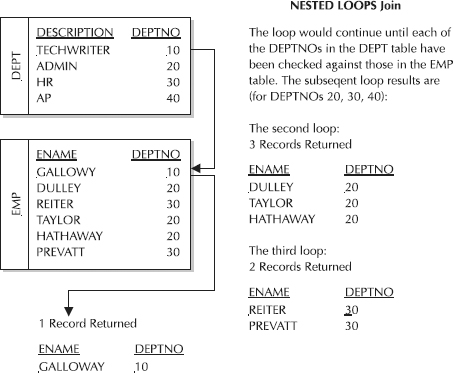Suppose somebody gave you a telephone book and a list of 20 names to look up, and then asked you to write down each person’s name and corresponding telephone number. You would probably go down the list of names, looking up each one in the telephone book one at a time. This task would be pretty easy because the telephone book is alphabetized by name. Moreover, somebody looking over your shoulder could begin calling the first few numbers you write down while you are still looking up the rest. This scene describes a NESTED LOOPS join.
In a NESTED LOOPS join, Oracle reads the first row from the first row source and then checks the second row source for matches. All matches are then placed in the result set and Oracle goes on to the next row from the first row source. This continues until all rows in the first row source have been processed. The first row source is often called the outer or driving table, whereas the second row source is called the inner table. Using a NESTED LOOPS join is one of the fastest methods of receiving the first records back from a join.
NESTED LOOPS joins are ideal when the driving row source (the records you are looking for) is small and the joined columns of the inner row source are uniquely indexed or have a highly selective nonunique index. NESTED LOOPS joins have an advantage over other join methods in that they can quickly retrieve the first few rows of the result set without having to wait for the entire result set to be determined. This situation is ideal for query screens where an end user can read the first few records retrieved while the rest are being fetched. NESTED LOOPS joins are also flexible in that any two-row sources can always be joined by NESTED LOOPS—regardless of join condition and schema definition.
However, NESTED LOOPS joins can be very inefficient if the inner row source (second table accessed) does not have an index on the joined columns or if the index is not highly selective. If the driving row source (the records retrieved from the driving table) is quite large, other join methods may be more efficient.
Figure 1 below illustrates the method of executing the query shown next where the DEPT table is accessed first and the result is then looped through the EMP table with a NESTED LOOPS join. The type of join performed can be forced with a hint and will vary due to different variables on your system.
![]()

Table 1. NESTED LOOPS (DEPT is the driving table)
[…] CLUSTER join in Oracle is really just a special case of the NESTED LOOPS join that is not used very often. If the two row sources being joined are actually tables that are part […]